AMD's Radeon HD 6450: UVD3 Meets The HTPC
by Ryan Smith on April 7, 2011 12:01 AM ESTPower, Temperature, and Noise
Last but not least as always is our look at the power consumption, temperatures, and acoustics of the Radeon HD 6450. Our power usage data should closely mirror any other 6450, but with a variety of passively cooled and actively cooled cards, many retail 6450s will be quite different.
Please note that we’re only including dGPUs here. Sandy Bridge power consumption is not even comparable due to the difference in everything from the CPU to the PSU.
| Radeon HD 6450 Voltage | |||
| 6450 Idle | 6450 Load | ||
| 0.9v | 1.15v | ||
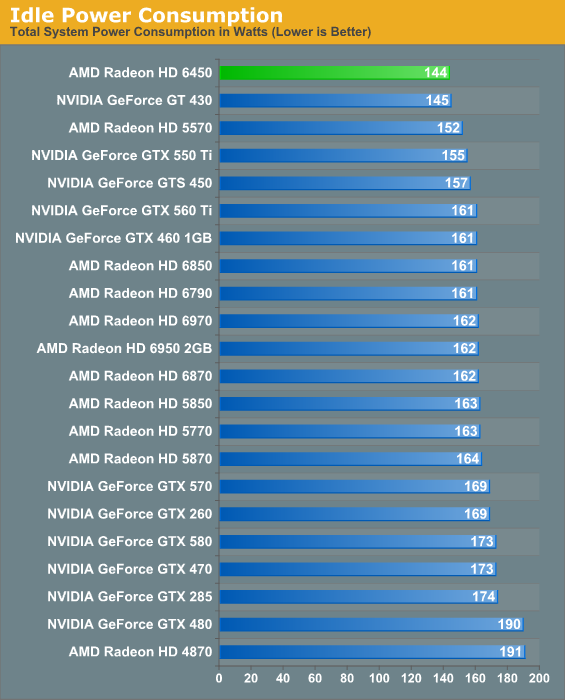
At idle the 6450 pulls about as little as we can get away with on our 1200W Antec Quattro PSU. It’s without a doubt the lowest idle power consumption out of this current generation of GPUs.
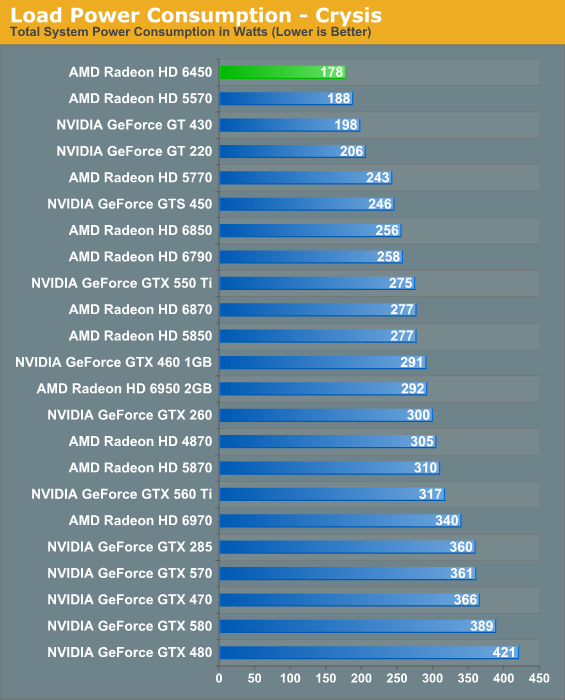
Under Crysis we see how much 27W does, or rather doesn’t contribute to total system power consumption. The only DX11 card competitive with these level of power consumption is the 5450; the next-lowest card is the 5570 which starts out at 10W higher. This low power consumption is what helps to make the 6450 a good candidate for passive cooling and HTPC use.
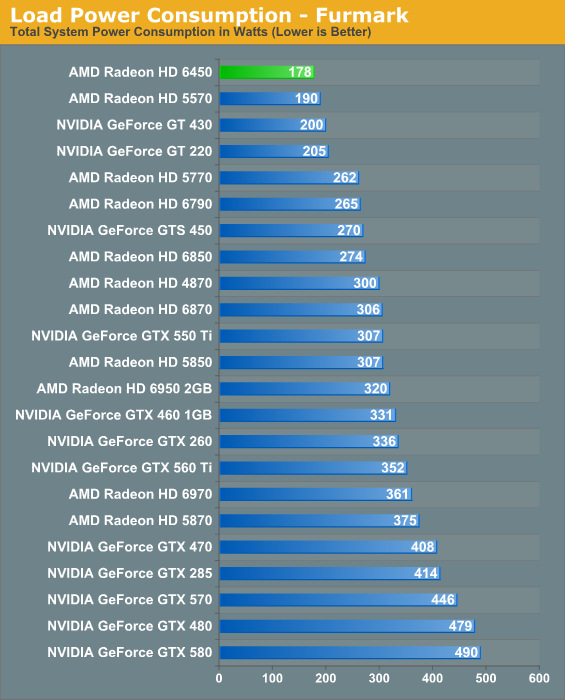
A bit surprisingly power consumption under Furmark is the same as it is under Crysis: 178W at the wall. This is likely due to lower CPU power consumption while at the same time GPU power consumption rises. Considering every other card has crept up at least some, this further highlights just how little power the 6450 consumes.
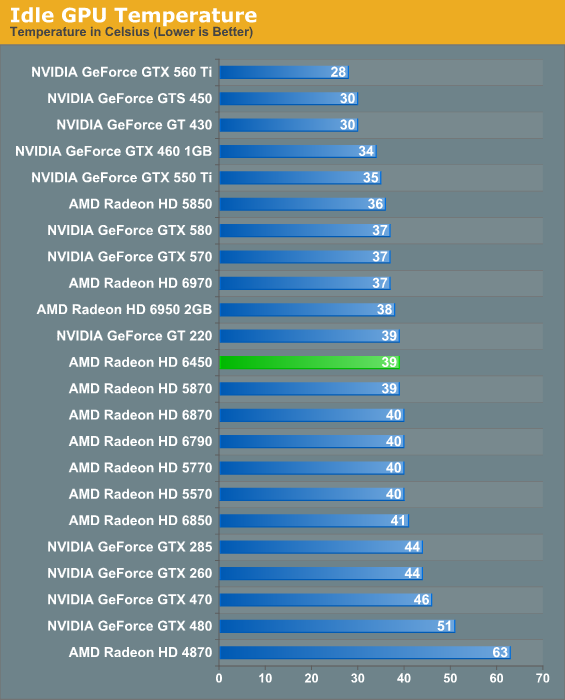
The cooler on the 6450 is identical to the cooler on our 5570 sample, so it shouldn’t come as a surprise that cooling characteristics are similar even with the lower power consumption. In this case an idle temperature of 39C is not close to being record-breaking, but it is consistent with this cooler. Running the fan faster could lower the result at the cost of noise, but there's no need.

Now load tempeartures on the other hand can certainly set some records. At 59C under Crysis the 6450 is tied with the 5570 for the coolest actively cooled card. We’re actually surprised it doesn’t do a bit better here given the similar cooler but lower power consumption.
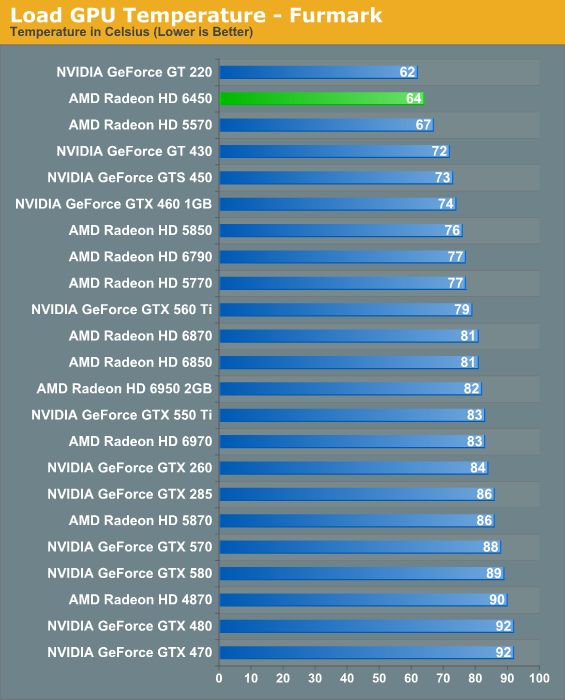
Under Furmark the GT 220 does manage to edge out the 6450, but the 6450 is still the coolest AMD card by 3C. It’s an interesting contrast from a couple of weeks ago when we were looking at dual-GPU monsters; 64C is practically lukewarm.
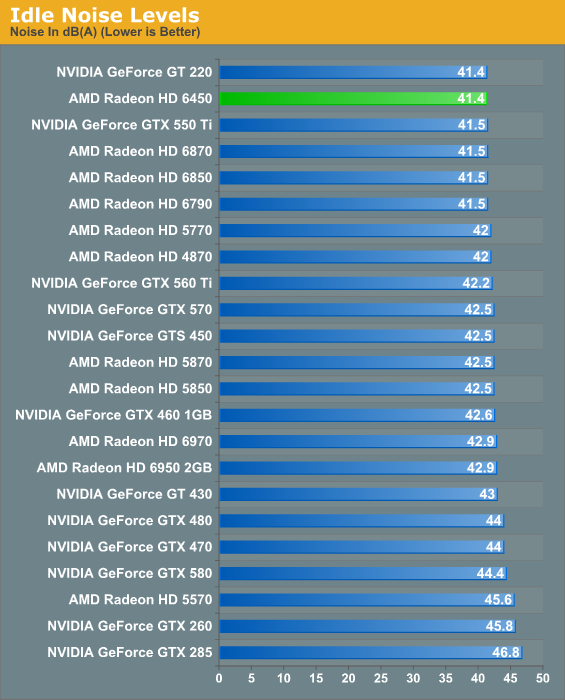
Under idle the 5570/6450 cooler is consistent with most other well designed coolers: it’s quieter than the noise floor of our testbed.
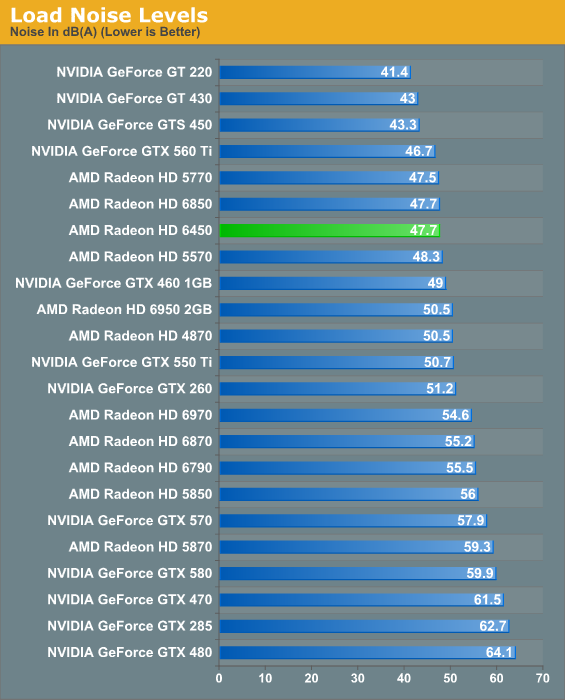
So the downside to the active cooler being used is that it’s not very quiet. If you want a quiet 6450 you’re better served by a passively cooled model for obvious reasons. But even if you want an actively cooled model, we strongly suspect you’ll see better coolers than the one on our sample. There’s no reason an active cooler needs to be more than a couple of dBA off of our noise floor—the GT 430 proves that.










47 Comments
View All Comments
ET - Thursday, April 7, 2011 - link
If you're worried about crossing the 25W line you can always slightly underclock it. That said, unless you intend to use it for gaming, folding or another such heavy task, it shouldn't come close to 25W, and from your description above it sounds like you're not planning such things.DjPete2008 - Friday, April 8, 2011 - link
According to this - http://www.rage3d.com/reviews/video/amd_hd6450_lau... - the idle power draw is actually less than the 5450.So it would probably be compatible with my system, and as ET said, I could also underclock it. Now to wait and see what retail products get released.
Wave_Fusion - Thursday, April 7, 2011 - link
Since the Turks architecture is what my 6770M is based on, I'm looking forward to see how the desktop versions do. It might not be as impressive in the desktop world, but as mobility cards go its not far from the top.evolucion8 - Thursday, April 7, 2011 - link
It is a good review, but I think that it might be more productive doing video quality analysis instead of gaming performance as no one will buy such low end card for gaming anyways. Or at least two or three gaming performance charts and the rest with video quality and performance analysis, good product overall, but in terms of gaming performance, I think that the GT 430 is a better option.Mishera - Friday, April 8, 2011 - link
I second that.I've been thinking about building a htpc using Amd's e-350, and was wondering if something like this would be useful from a feature/video quality perspective, or if the apu would be adequate on it's own.
ET - Friday, April 8, 2011 - link
I always find gaming potential interesting, but I think that 1680x1050 maximum quality with 4x AA isn't. I don't really need putting this in the perspective of all the other cards just to show it's not good for that. I want to know what it does work for. 720p would be a good testing point for an HTPC. 1280x1024 and 1024x768 aren't really in use these days.It might be a good idea for Anandtech to develop a low end gaming benchmark, with game and setting selections which are more useful to indicate the suitability of such low end hardware for some gaming. I know Jarred is working on a low end gaming article, but I'd love this to be put into standard reviews of such hardware.
7Enigma - Friday, April 8, 2011 - link
The majority of non-gamers (those that would probably buy this card not for HTPC), are on 17-19" monitors (ie those that come with the Dell/HP) computer and so I would argue that the 1280X1024 is likely the MOST important resolution to test.Still I agree with the above poster that the game tests are more of a formality and the focus should be on the video quality and performance analysis (specifically power draw doing common HTPC tasks not a load benchmark with crysis).
strikeback03 - Friday, April 8, 2011 - link
Unless that Dell/HP is pre-2005, it is probably not not 1280x1024. The various widescreen resolutions with between 768 and 900 pixels of vertical resolution have been more common for quite a while at those screen sizes.ET - Thursday, April 7, 2011 - link
Low end Llano chips will have 160 cores, but slower and with slower memory. That'd put it around HD 3000 or even under (and sometimes higher), but still over HD 2000.silverblue - Friday, April 8, 2011 - link
Tough call. Llano will have access to a dual channel memory bus of up to DDR3-1866 which theoretically should provide more bandwidth than the 6450, although it will have to share this with the rest of the system. Even so, this should still be plenty enough to beat HD 3000 regardless of what Llano model is in use, assuming the fastest memory is used.I believe Llano's true strength will be 720p with AA; even with 400 shader cores it's not going to be a monster and certainly won't be suited for 1080 gaming. Hell, I wouldn't even put my 4830 through that. One thing we really don't know right now is how many texture units and ROPs Llano actually possesses.